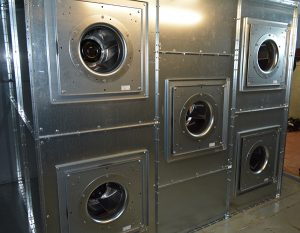
When the motor of the only double axial fan broke down, the entire air conditioning system for the check-in area of the Birmingham Airport shut down.
Around 13 million passengers fly from Birmingham Airport to one of 150 direct global destinations every year, plus a further 340 one-stop long-haul routes, with 50 airlines. Normally, they check-in, eat, shop or simply wait for their flight in pleasantly fresh air. But in February 2017, the motor of the only double axial fan broke down. The result: the entire air conditioning system for the check-in area of the seventh largest airport in Great Britain shut down. Airport management needed help quickly and contacted service provider and air treatment experts Munters, who in turn looked to ebm-papst UK for support.
Failure impossible with FanGrid

The FanGrid solution with five EC RadiPac fans prevents whole system failure. In addition, it saves considerable amounts of energy.
“Instead of replacing the fan, which would be a very difficult task due to its size, we recommended a new FanGrid design with five EC RadiPac fans,” said Kurt Bruns, a project engineer at ebm-papst UK. This solution not only saves considerable amounts of energy, but prevents whole system failure. “If one fan were to fail, the remaining four can increase their speed,” he explained. “They can compensate for the loss and continue to deliver the air volume required.” Due to their compact size, the units in a FanGrid can be replaced more easily. In addition, EC FanGrid solutions can be controlled more accurately, are quieter and reduce maintenance costs.
Consumes 58 percent less energy
These arguments convinced airport management. Munters installed the new system only two weeks after submitting the proposal. “The retrofit has reduced Birmingham Airport’s energy consumption by 58 percent,” said Bruns. Going from a power consumption of 24 kW to 6.4 kW saves the airport over €12,000 per year.

Una solución lógica, varias fuentes son mas manejables y seguras, dificilmente fallen simultaneamente. Se puede optimizar el consumo eléctrico en función de la demanda. Muy inteligente y bien pensado.